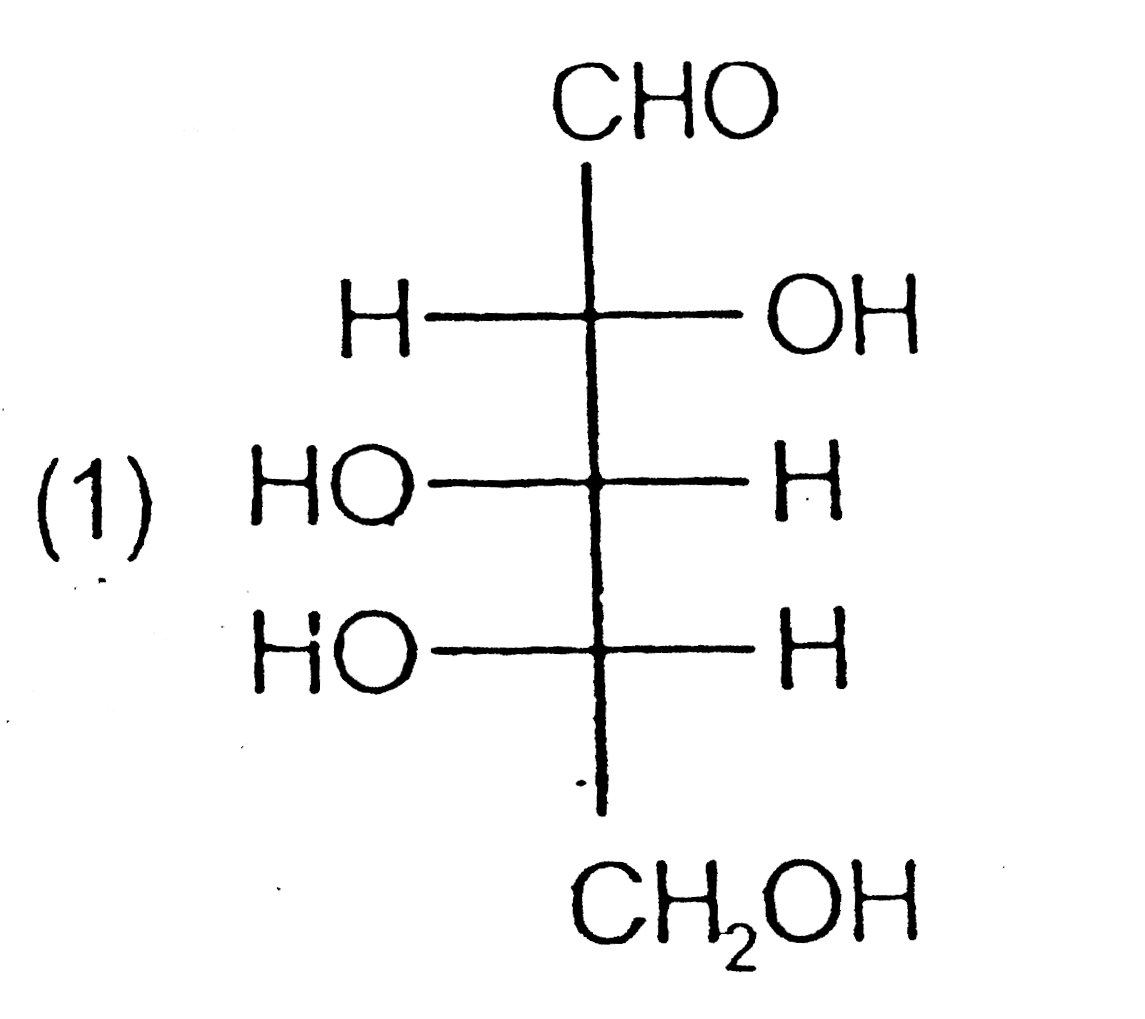Which of the following aldoses will give achiral product with NaBH4?




The correct Answer is:B, C
To determine which aldoses will give achiral products when treated with NaBH4, we need to analyze the structures of the aldoses provided in the options. The key point is to look for a plane of symmetry in the resulting product after reduction, as achiral compounds have a plane of symmetry.
1. Understanding the Reaction:
- NaBH4 (sodium borohydride) is a reducing agent that converts the aldehyde group (CHO) in aldoses to an alcohol group (CH2OH).
- The resulting product will be a sugar alcohol.
2. Identifying Aldoses:
- We need to analyze the structures of the aldoses given in the options. Each aldose has a carbon backbone with an aldehyde group at one end.
3. Analyzing Each Aldose:
- Option 1:
- When reduced by NaBH4, the aldehyde group (CHO) will become CH2OH.
- The resulting structure does not have a plane of symmetry, meaning it is chiral.
- Option 2:
- Upon reduction, the structure will also change, but this time, it will have a plane of symmetry.
- This means that the resulting product is achiral (optically inactive).
- Option 3:
- Similar to option 2, the reduction leads to a structure that has a plane of symmetry.
- Thus, this product is also achiral.
- Option 4:
- The reduction of this aldose does not yield a product with a plane of symmetry.
- Therefore, this product is chiral.
4. Conclusion:
- The aldoses that yield achiral products upon reduction with NaBH4 are found in Option 2 and Option 3.
Final Answer:
The aldoses that will give achiral products with NaBH4 are Option 2 and Option 3.
---
- NaBH4 (sodium borohydride) is a reducing agent that converts the aldehyde group (CHO) in aldoses to an alcohol group (CH2OH).
- The resulting product will be a sugar alcohol.
- We need to analyze the structures of the aldoses given in the options. Each aldose has a carbon backbone with an aldehyde group at one end.
- Option 1:
- When reduced by NaBH4, the aldehyde group (CHO) will become CH2OH.
- The resulting structure does not have a plane of symmetry, meaning it is chiral.
- Upon reduction, the structure will also change, but this time, it will have a plane of symmetry.
- This means that the resulting product is achiral (optically inactive).
- Similar to option 2, the reduction leads to a structure that has a plane of symmetry.
- Thus, this product is also achiral.
- The reduction of this aldose does not yield a product with a plane of symmetry.
- Therefore, this product is chiral.
- The aldoses that yield achiral products upon reduction with NaBH4 are found in Option 2 and Option 3.
The aldoses that will give achiral products with NaBH4 are Option 2 and Option 3.
Topper's Solved these Questions
- BIOMOLECULESBOOK - AAKASH INSTITUTE ENGLISHCHAPTER - BIOMOLECULESEXERCISE - Section-D (Comprehension Questions )
9 Videos
- BIOMOLECULESBOOK - AAKASH INSTITUTE ENGLISHCHAPTER - BIOMOLECULESEXERCISE - Section-E (Assertion-Reason Type Questions )
5 Videos
- BIOMOLECULESBOOK - AAKASH INSTITUTE ENGLISHCHAPTER - BIOMOLECULESEXERCISE - Section-B (Objective Type Questions (One option is correct))
11 Videos
- AMINES BOOK - AAKASH INSTITUTE ENGLISHCHAPTER - AMINES EXERCISE - Assignment Section -J (Aakash Challengers Questions)
9 Videos
- CHEMICAL BONDING AND MOLECULAR STRUCTURE BOOK - AAKASH INSTITUTE ENGLISHCHAPTER - CHEMICAL BONDING AND MOLECULAR STRUCTURE EXERCISE - Assignment Section J (Aakash Challengers Questions)
10 Videos
Similar Questions
Knowledge Check
Which of the following reactions will give identical products ?
A B
B C
C D
D
Which of the following reactions would give identical product?
A BCH3−O∣∣C−HCH3MgBr−−−−−−−−→⊕H/H2OPCC−−→CCH3−CH3∣C=CH−CH3OsO4−−→HIO4−−→DCH3−CH−CH3alc.KOH−−−−−→O3−−−−−−→Zn−H2O
BCH3−O∣∣C−HCH3MgBr−−−−−−−−→⊕H/H2OPCC−−→CCH3−CH3∣C=CH−CH3OsO4−−→HIO4−−→DCH3−CH−CH3alc.KOH−−−−−→O3−−−−−−→Zn−H2OWhich of the following reactions will give ether as main product?
A BMe3C−OHNa−−−−→C6H5BrCMe3C−OHNa−−−−−−−−−→CH3CH2CH2BrDCH3CH2CH2OHNa−−−−−−→Me3C−Br
BMe3C−OHNa−−−−→C6H5BrCMe3C−OHNa−−−−−−−−−→CH3CH2CH2BrDCH3CH2CH2OHNa−−−−−−→Me3C−Br
Which of the following reactions give alkylation product :
View SolutionWhich of the following give para major product with aniline?
View SolutionWhich of the following Allene is achiral?
View SolutionWhich of the following reaction/s give same product?
View SolutionWhich of the following reactions give alkylation product ?
View Solution

